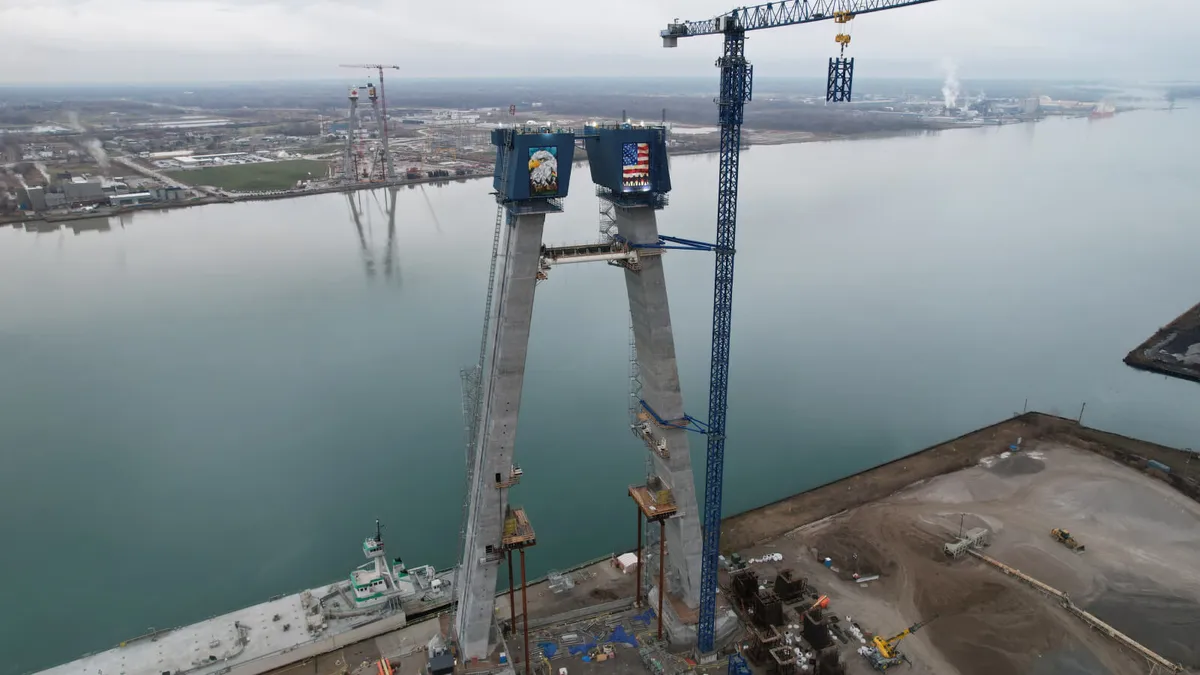Dive Brief:
- Construction on the $4.5 billion Gordie Howe International Bridge between Detroit and Windsor, Canada, is moving to its next stage, project spokesperson Tara Carson said, as the 1.5-mile span's tower legs take shape. It will be among the five longest bridges in North America when finished, and will supplement what is currently the countries' busiest land border crossing.
- Four main components make up the overall project: the bridge, U.S. and Canadian ports of entry and a Michigan interchange. It aims to boost vehicle capacity and border processing via sustainable infrastructure, according to bridge officials. Construction started in 2018 and the opening date for the bridge is slated for 2024.
- Canada is footing the bill for the effort, which is managed by a public-private partnership made up of the Windsor-Detroit Bridge Authority, a not-for-profit corporation, and Bridging North America, a consortium of ACS Infrastructure, Fluor and Aecon. BNA will design, build and maintain the bridge, per the project site.
Dive Insight:
The Gordie Howe Bridge has been in the works since 2000, when officials from both sides of the border began the planning process. Once complete, the bridge will include six motor vehicle lanes (three each traveling to the U.S. and Canada) and an 11-foot-wide foot and bike path. It will accomodate 34 million pounds.
The bridge is named after legendary Canada-born hockey player Gordie Howe, who helped the Detroit Red Wings win four Stanley Cups. Howe died in 2012 at the age of 88.
The tower legs, or pylons, have been under construction since 2019. Now, concrete must be poured to connect their top and lower members, work that will continue through the spring.
Next, work will begin on the pylon head, where anchor boxes will house cables to connect the towers and bridge decks, according to a project press release. This portion will continue through 2022 and will be easily visible to west Windsor and Southwest Detroit residents. Work on the deck is slated to begin in 2023.
Competing bridge owners sue to derail project
While project officials said they have stayed on target with construction goals and deadlines despite the pandemic, they have also faced ongoing legal challenges from the American billionaire family that owns the 92-year-old competing Ambassador Bridge upriver. The Mouroun family has sued and appealed to then-President Donald Trump to stop the project.
About 27% of the annual $400 billion trade between the U.S. and Canada traverses the privately-owned Ambassador Bridge, according to the Windsor Star, but the crossing has long been plagued by congestion, particularly for trucks.
Most recently, companies controlled by the Mouroun family filed a suit arguing that Michigan’s DOT could not spend tax dollars on the Gordie Howe project because it had previously voted against such an investment, according to the Windsor Star. The Michigan Supreme Court rejected the appeal in April 2021, declining to revisit a lower court ruling that the state is not in violation because Canada fully reimburses its project expenditures.
The Mouroun family sought to build another bridge next to the Ambassador Bridge, but the Detroit City Council voted down a deal to enable the project in 2021, according to the Detroit Free Press.
Beyond the bridge
The Gordie Howe project also includes two new ports of entry (POE) on either side, as well as a revamped interchange in Michigan. Carson, the project spokesperson, said work on all components is proceeding simultaneously.
The U.S. and Canadian POEs span 167 and 130 acres respectively, and will contain inbound and outbound inspection facilities. The plazas will be large enough to add processing facilities if necessary. Both POEs will be among the largest in North America, according to project officials.
In Detroit, an updated highway interchange will add five new pedestrian walkways and four new overpasses. Key intersections will be widened to improve the flow of traffic for trucks and other transport vehicles, and better connect I-75 and the U.S. POE.
Toll stations will be installed on the Canada side; investors anticipate making back the money invested in the project through future toll revenue.














